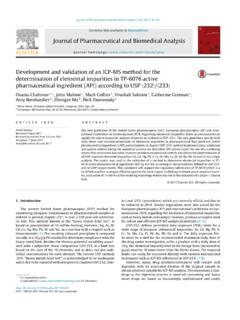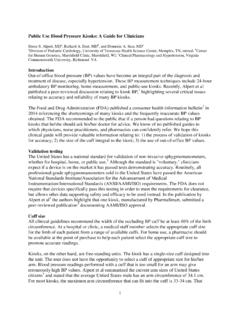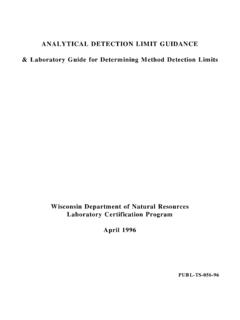Transcription of An introductory guide to biomarkers, precision ...
1 introductory guide to biomarkers , precision , personalised and stratified Richard Kennedy Global VP of Biomarker Development, Almac DiagnosticsThought LeadershipThe application of biomarkers to improve patient outcomes is now common in clinical trials and is rapidly being adopted into clinical most of what is being described in articles and at conferences is fairly straight forward, clinicians and scientists as well as the regulatory bodies in the US and EU tend to use what can be seen as fairly obscure terminology. In this article I have attempted to provide some clarity to this evolving field, particularly for those without a medical or scientific background. Several of the examples I use are in the area of cancer medicine , mainly because this has been at the forefront of biomarker development and also because I am a Medical Oncologist and cancer researcher by training. The concepts, however, are the same for the application of biomarkers to all human diseases.
2 For more detailed explanations of concepts covered here I would recommend the FDA website that has various useful of all we need to tackle the contentious issue of personalised medicine versus precision medicine versus stratified medicine . I have been on scientific advisory panels that have spent hours debating these terms with no resolution so it is not surprising there is considerable variation as to how they are used. Accepting that some people will disagree I have found the most useful way to think about these as the following: medicine : Selection of the bestapproach to managing a patient based onbiological measurements ( biomarkers ).For example: a person s genome is sequencedor a protein is measured in their blood and aspecific drug is given that is known to workwith their unique biology. It can also involverepeated monitoring of disease markers toallow tailoring of a treatment to an example, a specific cancer related genemutation or protein may be detected in bloodand disappear when successful treatmenthas been medicine : Selection of the bestapproach to managing a specific patient, basedon available biological information about thepatient as well as a patient s personalpreferences, environmental factors, socialfactors and other factors that may affect thetreatment choice.
3 This can be thought of anextension of precision medicine to a holisticapproach. An example may be the choice of aprophylactic salpingo-oophorectomy (surgicalremoval of fallopian tubes and ovaries) in anindividual who has tested positive for theBRCA1 or BRCA2 mutation, who has a familyhistory of ovarian cancer, is aware of the relativerisk of developing ovarian cancer themselvesand has decided to have no pregnancies inthe medicine : Selection of the bestapproach to managing a group of can be considered a step towards precisionand personalised medicine and is often usedfor treatment selection in clinical trials. Stratifiedmedicine accepts that the treatment selectedhas a net effect of benefiting a group of patientsas a whole but may not benefit every individualwithin the group. An example may be the useof the estrogen receptor to select hormonetreatment in breast cancer. The majority (70%)will benefit, but it is accepted that some will are required for precision , personalised and stratified medicine .
4 Again there are multiple definitions for these, many that are quiet complex. The official FDA definition is here and the European Medicines Agency (EMA) discusses biomarkers here. Basically a biomarker is something you measure to let you know if a person is healthy, not healthy, at risk of becoming unhealthy, or if unhealthy is responding to a treatment. biomarkers can be anything that can be measured in a person and can range from DNA, RNA, Protein, metabolites measured from samples such as blood, tumour material, urine or saliva to imaging such as digital pathology and radiology with special contrast agents. Other examples are blood pressure as a biomarker for risk of heart disease and blood sugar and HBA1c as biomarkers for risk of diabetes related health problems. biomarkers can be qualitative or quantitative. Qualitative biomarkers are either present or not. For example a KRAS mutation can either be measured in a cancer or not. Quantitative biomarkers measure something using a continuous scale.
5 For example a blood sugar is measured as a numerical concentration in blood. Tumour mRNA is often measured as a number relative to a control mRNA for which the level is known. Quantitative biomarkers will usually have associated values which represent cut-offs above (or sometime below) which is considered abnormal (biomarker positive). A working classification of biomarkers is given in the following table. Each would require an article to describe them fully, but it is worth discussing prognostic and predictive biomarkers in more detail as these often cause prognostic biomarker is used to estimate the outcome for a patient in the absence of a treatment. For example, if a patient has surgery for breast cancer how likely are they to be cured without further (adjuvant) chemotherapy?The Oncotype Dx and MammaPrint assays are examples of prognostic biomarkers used to help answer this question. A predictive biomarker is used to estimate the benefit for a specific treatment.
6 When a predictive biomarker is registered with a regulatory body (such as the FDA) along with an associated drug to select appropriate patients it is referred to as a companion diagnostic and is on-label for the drug. Using the breast cancer example again, HER2 overexpression (predictive biomarker positive) indicates potential benefit from trastuzamab (Herceptin) treatment. HER2 overexpression is a companion diagnostic on-label for trastuzumab and the FDA require it is tested prior to prescribing this drug. The FDA discuss these definitions and the use of companion diagnostics further common point of confusion is where a specific intervention such as chemotherapy is shown to have an overall benefit in a high risk population as identified by a prognostic biomarker. This does not necessarily mean the biomarker is predictive for the treatment. For example, the breast cancer prognostic biomarkers mentioned earlier will identify high-risk patients who should be offered adjuvant chemotherapy (The low risk patients are unlikely to develop recurrent disease and therefore will not need chemotherapy).
7 The actual benefit for chemotherapy used for an individual high-risk patient however is unknown as the prognostic biomarker does not measure the biology that determines sensitivity or resistance to chemotherapy. Rather it is designed to predict the aggressiveness of a tumour and its likelihood of metastatic spread. This means that the overall response rate is probably less than 50% for standard adjuvant chemotherapy in the high risk population. Ideally a predictive biomarker that measures mechanisms of sensitivity or resistance would be used along with the prognostic biomarker to select the correct chemotherapy for the patient s specific patient at risk of disease?BRCA1 mutation and risk of breast cancer. CAG Repeats and Huntington s / BiomarkerIs disease present?D-Dimer measurement and deep venous thrombosisPSA and presence of prostate treatment needed?HBA1C levels and complications of assay and risk of breast cancer treatment?KRAS mutation and cetuximab resistance in colon cancer.
8 ER and response to tamoxifen in breast treatment safe?The CYP2C9*3 single nucleotide polymorphism in germline DNA reduces warfarin metabolism by 90% increasing the risk of overtreatment and the treatment as prescribed working at a biological level?Loss of Ki67 as marker of decreased proliferation in cancer. Blood pressure as a response to biomarkerIs there a change in the disease with time?Hepatitis C virus ribonucleic acid (HCV-RNA) for assessing patients with chronic hepatitis the patient fit for treatment?Renal function tests prior to platinum-based validation This again is an area of much confusion with several different terms used. There are, however, two main aspects to proving a biomarker is fit for purpose that can be summarised as:I. Analytical validation . This is the proof that the biomarker is technically robust (ie it measures what it is supposed to reliably). This is what the clinical Laboratory Improvement Amendments (CLIA) legislation is primarily focussed on in the US.
9 Indeed, in order to be able to use a biomarker for the selection of patient treatment in many US states, including clinical trials, the assay must be compliant with CLIA biomarker validation requirements. This typically includes:a. Accuracy - does the biomarker measure what it is supposed to? Usually it needs to be compared to another measurement technique to demonstrate comparable data. b. precision - does the biomarker give the same result for the same sample every time it is run or is the technology/process noisy with a lot of variation?c. Analytical Sensitivity - what is the minimum amount of biological material (eg DNA from blood) that is required to give a reliable result?II. clinical validation . This is proof that the biomarker can be used for the clinical purpose for which it has been designed. The FDA and EMA require adequate clinical validation before a biomarker can be routinely used in the clinic. The process usually involves the application of the biomarker to a patient population that is entirely different (the validation dataset) to that used for the purpose of discovery and development (the training dataset).
10 The true ability of the biomarker to guide precision medicine can be estimated in terms of sensitivity (ability to identify those patients with an adverse outcome and distinct from analytical sensitivity mentioned above) and specificity (ability to identify those who do not have the adverse outcome). Sometimes the validation can be given in terms of a Hazard Ratio (HR) which is a measure of the biomarker s ability to predict the risk of developing an adverse event over time such as cancer recurrence, stroke, death etc. A P-Value indicates the level of statistical certainty that the biomarker is performing, with a value of less than conventionally indicating it is working as expected. verification is best reserved for the analysis of a sample set to ensure that a diagnostic lab can run a commercially available biomarker accurately and to the manufacturer s example, a lab may acquire kits from a vendor to measure HER2 amplification. They will need to show that they generate comparable results to other labs when analysing a set of verification samples before offering the assay to article has covered some of the main concepts of biomarker application which will hopefully orientate those new to the field and provide a working knowledge.













